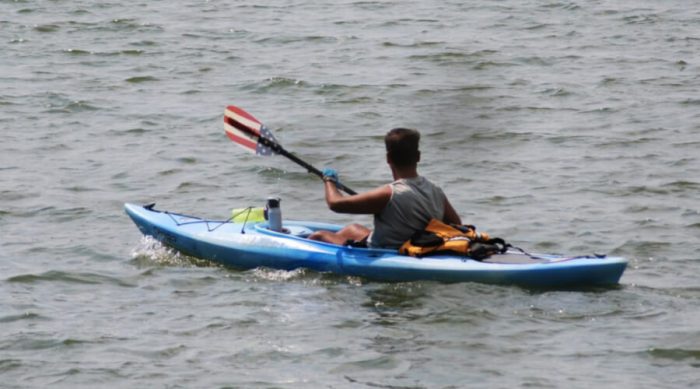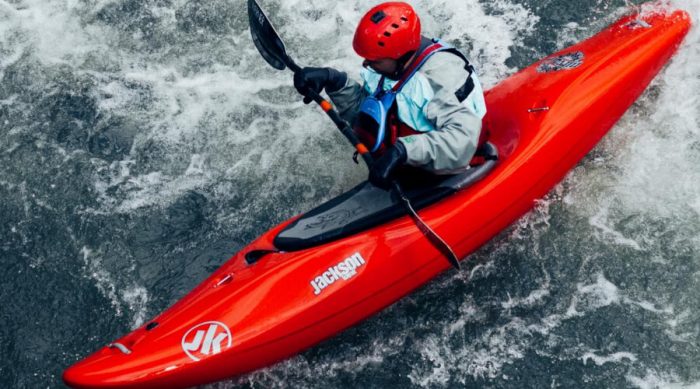It is possible for a kayak to capsize, or flip over, in the water. If this happens, then there are chances that you may drown also. Therefore it is very important to wear a personal flotation device, or life jacket when kayaking.
Key Takeaways
- Some potential danger of kayaking is, Capsizing, Obstacles, Getting Lost, Wild Animals, rough water and weather, etc.
- If you flip upside down with your kayak, then you should not be panicked, try to stay calm and handle the situation accordingly
- If you flip upside down then you should try to remain close to the kayak because the boat will keep you safe when you are underwater
- If you are not entirely upside down then try to snap your hips a bit to help you turn completely
Is Kayaking Dangerous?

Kayaking can be a dangerous activity as we were not made for water. It requires one to have some skills and take precautions. Let us look at some factors that make kayaking dangerous. All of the factors discussed below may lead to flipping upside down in your kayak.
1. Capsizing
Since we are talking about capsizing in this article, it means it is one of the many dangers you can face while kayaking. You may flip the kayak over, and if nature is working against you, get trapped under it. It happens a lot, and this is not something new for whitewater kayakers. You should always wear your PFD and learn self-rescue and stay calm for safety purposes.
2. Obstacles
The fact that the titanic capsized because of an iceberg should tell you a lot. When the captain saw the tip, a whole iceberg was just below the surface. The same thing can happen to you, or you may not see anything at all.
3. Getting Lost
It is possible to get lost, especially if you go sea kayaking. Sea waters are calm and may seem attractive to kayak in, but you can quickly lose the sense of direction after getting away from the shore. You should ensure to have a compass and a GPS. You should also keep track of time and keep the shore in sight.
4. Wild Animals
When you go kayaking, you’ll be going into the wild—meeting wild animals should, for this reason, not come as a surprise. You can come across all types of animals-from just the small annoying ones, like mosquitoes to big and dangerous like sharks. It is essential to do your research before you head out. Find out which animals can be found where you want to kayak and if you can avoid their paths, do so.
5. Other Watercrafts
if you kayak a lot, you have probably come across other crafts. You may meet other kayakers, speed boats, and other large watercraft like ferries and ships. If you crash, the fatality will depend on the size of the watercraft. Crashing is more likely to happen at night since it is dark, and yes, either you or the one operating the other craft may be dozing off and losing their concentration. When kayaking at night, you should wear reflective clothing and have a 360-degree white light. This ensures that you can be seen even from a distance.
6. Weather And Water Conditions
As unpredictable as the weather, they say. The weather may change quickly even though it could have just been looking calm and sunny and a beautiful day to kayak. It would help if you turned back at the slightest weather change because kayaks cannot protect you from adverse weather conditions. For instance, water will collect in your kayak if it starts raining, and you may even be struck by lightning. Ensure that you check the weather forecast and keep an eye on the sky.
Unforeseen tides and currents could be dangerous, especially if you don’t do whitewater kayaking. You will be left to fight alone with the waves, which will probably be overwhelming for you. You may also get lost easily when waves take charge of your boat. Plan your kayaking route and take the one least likely to have such water conditions unforeseen.
7. Overstepping
Sometimes you may be tempted to try waters you are not experienced for. Never give in to temptation. The water levels you choose should always match you’re your expertise. If you are a beginner, go to calm waters. Learn the basics first before you head out to waters a bit rough. Always do your research before going out, and know the kind of water you will face when you go there. Don’t let the tides come by surprise.
How To Exit Your Kayak While It Is Upside Down

If anything happens and you turn upside down when on your kayak, there are some things you have to do to ensure a safe exit. One slight mistake and things may go south, so you should ensure that you always remember what to do. It would help if you even practiced this in anticipation of when you will capsize.
1. Do Not Panic
When you flip upside down, you will need to remain calm. Acting in panic will only make things worse as you will lose your breath and get tired too fast, and you will kick too hard. This will make your boat move about, paralyzing your ability to leave the boat safely. It is easier to drown when you have panicked.
2. Do Not Stretch Out
Instead of stretching out, you should try to come as close to your kayak as possible. Tucking close to the boat will keep you safe when you are underwater, as you will be less likely to hit yourself on a rock. It could save your life, especially if you were kayaking in whitewater. However, you should do this no matter the type of water you kayak on.
3. Ensure You Are Upside Down
If you are underwater but not entirely upside down, snap your hips a bit to help you turn completely.
4. Roll Your Kayak
Determine whether you can flip your kayak when you are still on it. Grab your kayak by holding on to both sides of the seat, get your feet flat against the cockpit and then push yourself up. Do not lean back, as you will lose control of your boat. If you cannot get back up, it is time to pull the spray skirt.
5. Push Away The Boat
Before pushing the boat, you should ensure that the backrest hatches are not holding you, or else you’ll use your energy for nothing. It would be best to push the boat away as though you are removing a pair of pants. You should ensure no boulders or other obstacles in your way. If there are, you should try to get past them and get to as clear water as possible. If you are not careful, you may get out f the kayak, yes, but hit your head hard on a rock, increasing your chances of drowning.
6. Save Your Gear
After you save yourself, you should try and save the ones that cannot save themselves. Try to stay with your boat and paddle as much as possible, but remember that your safety is the priority.
What Happens When A Kayak Turns Over?
Kayaks are made to float on water, and a sit-on kayak will not sink as long as there is enough air inside. The scupper hole gets air inside, minimizing the risk of sinking. However, if the air pockets are filled with sand and other objects that prevent airflow, they may sink.
Bulkheads on a sit-in kayak prevent sinking when a hull breach occurs. When water gets inside, however, the chances of sinking are increased.
Final Thoughts
If you kayak a lot, you have flipped over, or you will. Sometimes nature may not be too friendly for you, and you need to know how to rescue yourself. Remember to practice self-rescue before heading out. This will reduce panic when you flip over and give you more confidence when you know what you are doing. You don’t have to know how to swim to rescue yourself, but it will be an added advantage. Just follow all the guidelines and precautions.
References:
- https://www.quora.com/Will-a-kayak-drown-me-if-it-turns-upside-down
- https://www.liveabout.com/wet-exiting-an-upside-down-kayak-2555962
- https://skyaboveus.com/water-sports/how-to-kill-yourself-in-a-kayak

Rockey is a kayaking enthusiast who has been kayaking with a local group for the last five years. He loves using kayaks while out on outings on the water or camping when the friends want to have a BBQ party somewhere on the bank of a local lake. More About James R Rockey at About Page Here: Authors
Based on his experiences with the different types of kayaks, he is sharing his opinion about kayaking tricks and required gears so that a beginner can get started right away.
Find his team on Twitter here. Happy reading!
